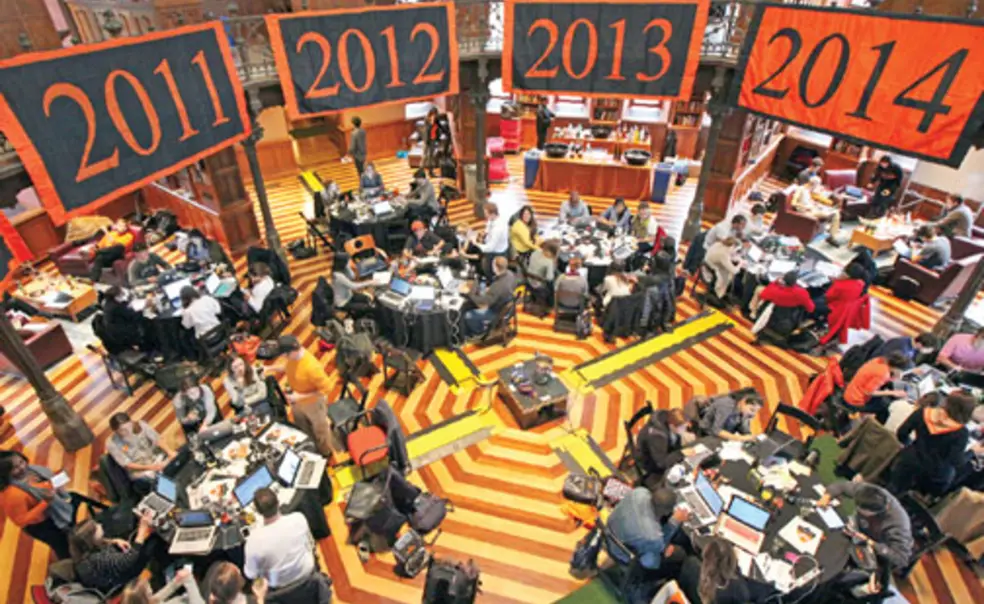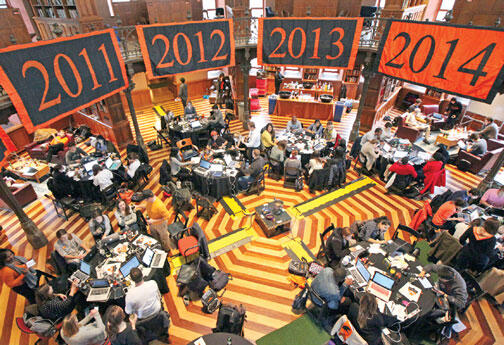The Enduring Tradition of Annual Giving
As Princeton grappled with escalating inflation and operating costs in the years after World War II, a group of 24 concerned undergraduates wanted their peers to understand the University’s financial condition.
The students sent a pamphlet to all undergraduates in October 1948 to explain factors affecting Princeton’s bottom line, including the high costs of educating each student, even those paying full tuition and fees; the need to support basic research beyond external funding from government, industry, and foundations; and the steep competition for top-quality faculty.
Thankfully, they noted, alumni had come “to the rescue.”
“Putting money in the sock for Princeton is a fine old custom among alumni and one that has made Princeton what it is,” they wrote. “…Without that kind of financial support, together with the moral support and interest which such generosity reflects, Princeton might just be another college.”
While times certainly have changed from 1948 to today’s globalized, technology-driven society, the issues shaping Princeton’s finances then remain fundamental now. And the sentiments expressed by those student pamphleteers — gratitude for our alumni’s role in making Princeton one of the world’s greatest universities — ring just as true today.
Princeton’s Annual Giving campaign was beginning its ninth year when that pamphlet was published. Now in its 75th year, Annual Giving is a source of vital, unrestricted funds that allow us to uphold our commitment to excellence in everything we do — attracting and empowering talented students from all backgrounds, recruiting and retaining world-class scholars, and serving society by educating future leaders and creating new knowledge.
Annual Giving has been critical, in particular, to maintaining our groundbreaking financial aid program. Continued support of Annual Giving by alumni and parents during the Great Recession of 2008 and 2009 enabled Princeton to increase our financial aid budget to support students and families who faced tough times. This was a wonderful reflection of the loyalty and commitment of our alumni, and it was greatly appreciated — as we saw at Class Day 2010, when keynote speaker and University Trustee Charles Gibson ’65 was interrupted by rousing applause while noting that alumni generosity enabled most students to graduate debt-free.
Annual Giving contributions also allow Princeton to seize new opportunities when great ideas come along, such as the Bridge Year Program and the Princeton Neuroscience Institute. While we, of course, need to raise major capital gifts to fully endow these initiatives, Annual Giving funds helped us get them started.
Our history shows that every gift matters. Late in the first Annual Giving campaign in 1940-41, founding chair Harold Helm ’20 reported that gifts ranged from 10 cents to $1,000. Today, gifts of $100 or less — which still come, as Helm described, “from the ends of the earth” — annually total $1.5 million. This is the equivalent of the annual income on $30 million of endowment. If Princeton were to receive a $30 million unrestricted donation to our endowment, we would quite accurately describe it as one of the largest such gifts in the University’s history. The cumulative impact of tens of thousands of gifts of various sizes is equally powerful, which is one reason why participation at all levels is so crucial to Princeton’s well-being and its future.
Beyond providing financial support, Annual Giving helps to bring the University and the alumni community closer together. When John MacLean Jr. 1816 founded what was then called the Alumni Association of Nassau Hall in 1826, he described its main purposes as building alumni community and fundraising. The strength of our alumni community today is multifaceted and, as any Reunions attendee knows, unparalleled. Participation as an Annual Giving donor or volunteer is among the most meaningful manifestations of alumni engagement and pride.
While I marvel at the dedication of all of our alumni, the participation of younger alumni classes and senior classes has been particularly gratifying. In last year’s Annual Giving campaign, the youngest 10 classes had an average participation rate of 72.1 percent. We are fortunate that the tradition of giving has been passed from each generation to the next, and that younger classes embrace this connection to the life of the University. Their dedication will help carry our alma mater forward.
When President Harold Dodds *1914 wrote in this magazine 75 years ago to encourage participation in the nascent Alumni Giving campaign, he could not have envisioned the growth in our spheres of scholarly exploration, our student body, and our campus size. But his message remains true, even though he presided over a much different Princeton.
“This money will be an expression of confidence in Princeton and in all that Princeton stands for as a privately maintained institution of learning at a time when every phase of our life is undergoing the closest scrutiny to determine its value in the national scheme,” President Dodds wrote. “… I believe that all of us here at Princeton and all of you alumni throughout the world share a common determination to have Princeton go forward, to have Princeton grow constantly greater.”














No responses yet